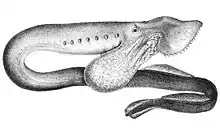| Geotria | |
|---|---|
 | |
| Drawing of Geotria australis by W. Wing | |
| Scientific classification | |
| Domain: | Eukaryota |
| Kingdom: | Animalia |
| Phylum: | Chordata |
| Infraphylum: | Agnatha |
| Class: | Hyperoartia |
| Order: | Petromyzontiformes |
| Family: | Geotriidae D. S. Jordan, 1923 |
| Genus: | Geotria J. E. Gray, 1851 |
| Species | |
| |
| Synonyms | |
| |
Geotria is the only genus in the lamprey family Geotriidae. It has 2 known species: Geotria australis (pouched lamprey) and Geotria macrostoma (Argentinian lamprey). Both species were considered conspecific until G. macrostoma was revived in a 2020 study.[1]
The family Geotriidae is most closely related to the lamprey family Mordaciidae, which has a similar Gondwanan distribution, and both families diverged during the Early Cretaceous. Together, their common ancestor diverged from the Petromyzontidae during the Middle Jurassic.[2]
G. australis spawns in Pacific-draining river basins in on either side of the southern Pacific (both Australasia and Chile), while G. macrostoma spawns in Atlantic-draining basins in southern South America and nearby subantarctic islands. Despite the occurrence of both species in South America and both formerly being considered conspecific, phylogenetic studies suggest that the lineages of both species diverged during the Late Cretaceous, indicating very ancient origins for both.[1][2]
References
- 1 2 Riva-Rossi C, Barrasso DA, Baker C, Quiroga AP, Baigún C, Basso NG (May 29, 2020). "Revalidation of the Argentinian pouched lamprey Geotria macrostoma (Burmeister, 1868) with molecular and morphological evidence". PLOS ONE. 15 (5): e0233792. Bibcode:2020PLoSO..1533792R. doi:10.1371/journal.pone.0233792. PMC 7259705. PMID 32470001.
- 1 2 Brownstein, Chase Doran; Near, Thomas J. (2023-01-23). "Phylogenetics and the Cenozoic radiation of lampreys". Current Biology. 33 (2): 397–404.e3. doi:10.1016/j.cub.2022.12.018. ISSN 0960-9822. PMID 36586410. S2CID 255278945.